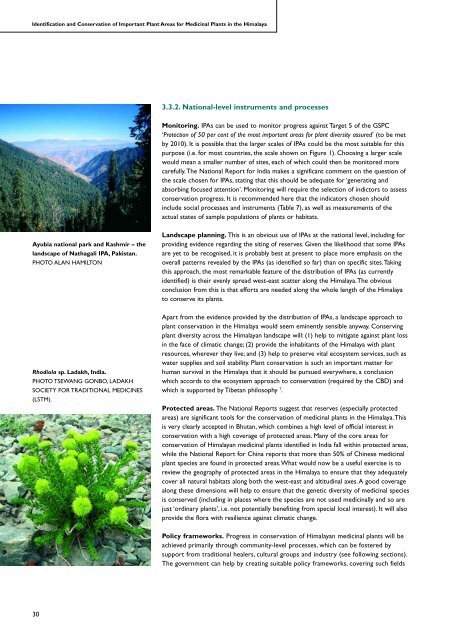Identification and Conservation of Important Plant Areas - Plantlife
Identification and Conservation of Important Plant Areas - Plantlife
Identification and Conservation of Important Plant Areas - Plantlife
- No tags were found...
Create successful ePaper yourself
Turn your PDF publications into a flip-book with our unique Google optimized e-Paper software.
<strong>Identification</strong> <strong>and</strong> <strong>Conservation</strong> <strong>of</strong> <strong>Important</strong> <strong>Plant</strong> <strong>Areas</strong> for Medicinal <strong>Plant</strong>s in the Himalaya3.3.2. National-level instruments <strong>and</strong> processesMonitoring. IPAs can be used to monitor progress against Target 5 <strong>of</strong> the GSPC‘Protection <strong>of</strong> 50 per cent <strong>of</strong> the most important areas for plant diversity assured’ (to be metby 2010). It is possible that the larger scales <strong>of</strong> IPAs could be the most suitable for thispurpose (i.e. for most countries, the scale shown on Figure 1). Choosing a larger scalewould mean a smaller number <strong>of</strong> sites, each <strong>of</strong> which could then be monitored morecarefully.The National Report for India makes a significant comment on the question <strong>of</strong>the scale chosen for IPAs, stating that this should be adequate for ‘generating <strong>and</strong>absorbing focused attention’. Monitoring will require the selection <strong>of</strong> indictors to assessconservation progress. It is recommended here that the indicators chosen shouldinclude social processes <strong>and</strong> instruments (Table 7), as well as measurements <strong>of</strong> theactual states <strong>of</strong> sample populations <strong>of</strong> plants or habitats.Ayubia national park <strong>and</strong> Kashmir – thel<strong>and</strong>scape <strong>of</strong> Nathagali IPA, Pakistan.PHOTO ALAN HAMILTONL<strong>and</strong>scape planning. This is an obvious use <strong>of</strong> IPAs at the national level, including forproviding evidence regarding the siting <strong>of</strong> reserves. Given the likelihood that some IPAsare yet to be recognised, it is probably best at present to place more emphasis on theoverall patterns revealed by the IPAs (as identified so far) than on specific sites.Takingthis approach, the most remarkable feature <strong>of</strong> the distribution <strong>of</strong> IPAs (as currentlyidentified) is their evenly spread west-east scatter along the Himalaya.The obviousconclusion from this is that efforts are needed along the whole length <strong>of</strong> the Himalayato conserve its plants.Rhodiola sp. Ladakh, India.PHOTO TSEWANG GONBO, LADAKHSOCIETY FOR TRADITIONAL MEDICINES(LSTM).Apart from the evidence provided by the distribution <strong>of</strong> IPAs, a l<strong>and</strong>scape approach toplant conservation in the Himalaya would seem eminently sensible anyway. Conservingplant diversity across the Himalayan l<strong>and</strong>scape will: (1) help to mitigate against plant lossin the face <strong>of</strong> climatic change; (2) provide the inhabitants <strong>of</strong> the Himalaya with plantresources, wherever they live; <strong>and</strong> (3) help to preserve vital ecosystem services, such aswater supplies <strong>and</strong> soil stability. <strong>Plant</strong> conservation is such an important matter forhuman survival in the Himalaya that it should be pursued everywhere, a conclusionwhich accords to the ecosystem approach to conservation (required by the CBD) <strong>and</strong>which is supported by Tibetan philosophy 7 .Protected areas. The National Reports suggest that reserves (especially protectedareas) are significant tools for the conservation <strong>of</strong> medicinal plants in the Himalaya.Thisis very clearly accepted in Bhutan, which combines a high level <strong>of</strong> <strong>of</strong>ficial interest inconservation with a high coverage <strong>of</strong> protected areas. Many <strong>of</strong> the core areas forconservation <strong>of</strong> Himalayan medicinal plants identified in India fall within protected areas,while the National Report for China reports that more than 50% <strong>of</strong> Chinese medicinalplant species are found in protected areas.What would now be a useful exercise is toreview the geography <strong>of</strong> protected areas in the Himalaya to ensure that they adequatelycover all natural habitats along both the west-east <strong>and</strong> altitudinal axes.A good coveragealong these dimensions will help to ensure that the genetic diversity <strong>of</strong> medicinal speciesis conserved (including in places where the species are not used medicinally <strong>and</strong> so arejust ‘ordinary plants’, i.e. not potentially benefiting from special local interest). It will alsoprovide the flora with resilience against climatic change.Policy frameworks. Progress in conservation <strong>of</strong> Himalayan medicinal plants will beachieved primarily through community-level processes, which can be fostered bysupport from traditional healers, cultural groups <strong>and</strong> industry (see following sections).The government can help by creating suitable policy frameworks, covering such fields30
















